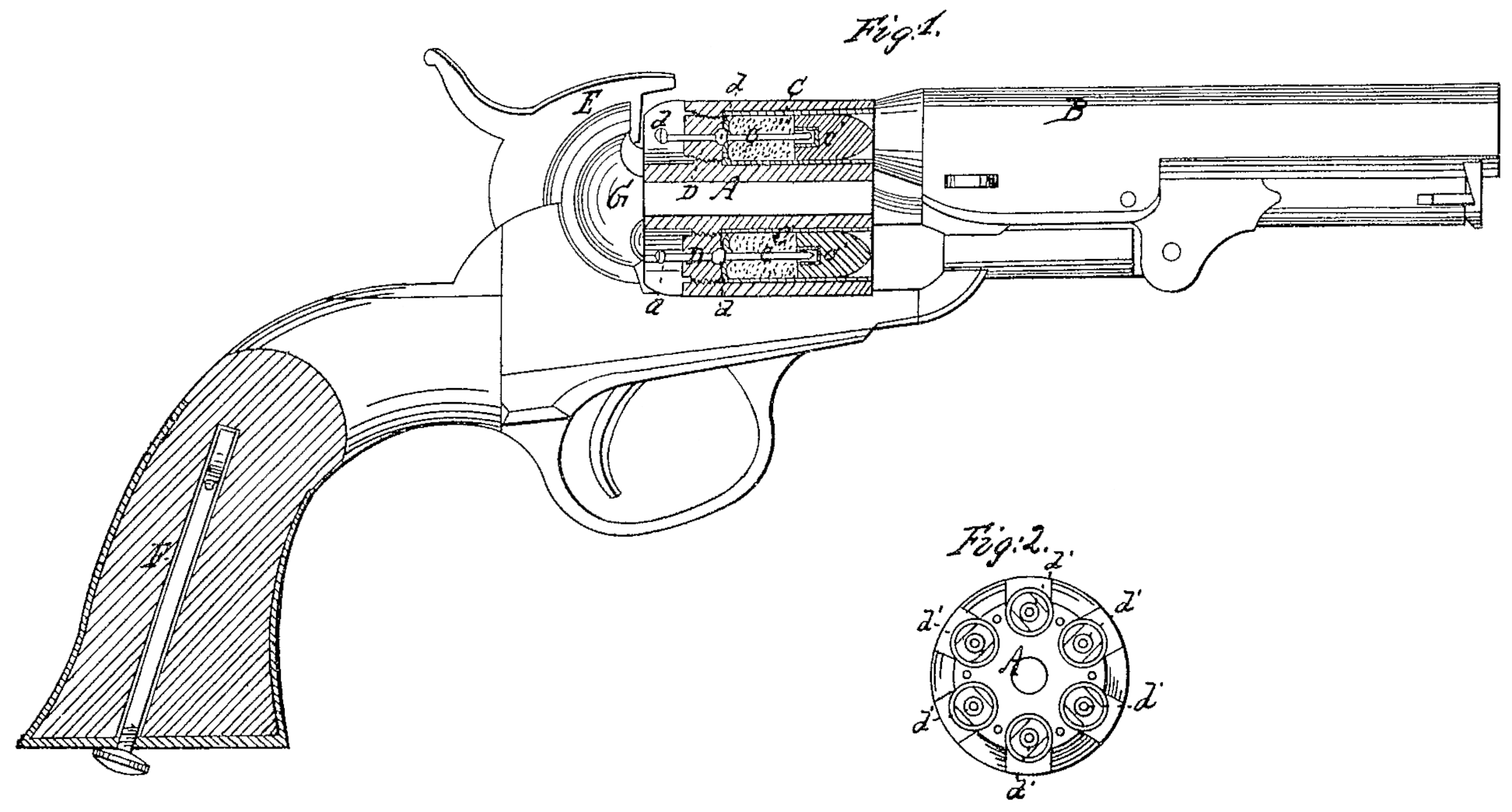US 46612
UNITED STATES PATENT OFFICE.
CHAS. EDWD. SNEIDER, OF BALTIMORE, MARYLAND, ASSIGNOR TO HIMSELF AND THOMAS POULTNEY, OF SAME PLACE.
AND THOMAS POULTNEY, OF SAME PLACE.
IMPROVEMENT IN REVOLVING FIRE-ARMS.
Specification forming part of Letters Patent No. 46,612, dated February 28, 1865.
To all whom it may concern:
Be it known that I, Charles Edward Sneider, of the city and county of Baltimore, in the State of Maryland, have invented a new and useful Improvement in Fire-Arms; and I do hereby declare the following to be a fall and exact description of the same, reference being had to the accompanying drawings, making part of this specification, in which—
Figure 1 is a sectional elevation of a revolver embodying my invention. Fig.2 is arear end elevation of the cylinder.
Similar letters of reference. indicate corresponding parts in both figures.
This invention consists in the use of pins fitted to slide within the rear ends of the chambers containing the cartridges, so that they may be impelled forward against pins or primers to-produce the explosion of the cartridges, and adapted to permit the exploded cartridge-shells to be readily withdrawn.
The fire-arm forming the subject of this application is particularly adapted for use in connection with the cartridge for which Letters Patent are granted to me bearing date on the 22d day of November, 1864, as will be hereinafter explained.
The following description will enable others skilled in the art to which my invention appertains to fully understand and use the same.
In the accompanying drawings the red lines indicate the parts which do not bear an essential relation to my invention.
A is a cylinder having any desired number of chambers, to be turned successively in line with. the barrel B in customary manner. Each chamber may be charged ‘from: the front end with a cartridge, C, whose explosion is produced by the forward movement, of a pin, c which strikes a percussion-primer, c’.
Through the base or rear part of each chamber in the cylinder C passes a pin, D, the ends of which are formed with beveled heads d d’. When one of the chambers of the cylinder is in line with the barrel Bits corresponding pin, D, occupies such a position that it may be impelled forward by the hammer E. A slight forward: movement of the cartridge-pin c is sufficient to explode the cartridge, and after the cylinder-pin D.has been driven against the cartridge-pin c said cylinder-pin D projects beyond the rear end of the cylinder A and abuts against or is in position from which it may be advanced against the cartridge-pin e, which is permanently fixed within the metallic cartridge and retains its central position therein after the cartridge has been exploded.
The forward movement of the hammer E is arrested as soon as it has driven the pin D forward to a sufficient extent to produce the explosion, and after the discharge the pressure f the hammer upon the pin D ceases. When after discharge the chambers are turned to proper position to admit of the withdrawal of he exploded shells, a rod, F, is inserted between the frame G and the cylinder A, and employed after the manner of a lever to exert a forward pressure upon the pins D and push the cartridge-shells partially out of their chambers, so that they may be readily taken hold of with the fingers and withdrawn.
If from any cause a cartridge should break or burst when the discharge takes place, the pin D of such cartridge will constitute an effectual gas-check. “As shown in Fig. 1 of the drawings, the rod F may be conveniently carried in the stock.
Having thus described my invention, the following is what I claim as new. therein and desire to secure by Letters Patent:
1. The pins D, passing through the rear part of‘the cylinder, and provided at their forward ends with heads d’, adapted to act as gas-checks in the event of gas escaping from the rear of the cartridge.
2. In combination. with the aforesaid pins. D, the described construction and relative arrangement of the rear end of the cylinder and the hammer, whereby the pins D, after having been: employed-for the explosion of the cartridges, are made capable of an additional forward. movement to effect the injection of the exploded shells, as explained.
CHARLES EDWARD SNEIDER.
Witnesses:
B, KLEIBACKER,
J. D. Moritz.

